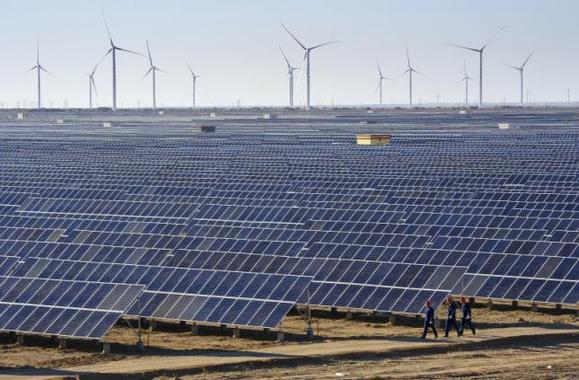China's 'green' transformation
|
 |
|
Workers walk past solar panels and wind turbines (rear) at a newly-built power plant in Hami, Xinjiang Uighur autonomous region, China, September 17, 2015. [Photo/Agencies] |
China has a track record of making rapid changes. Within just the past decade or two, the world’s most populous country has become its biggest market for cars and e-commerce, as well as its biggest exporter -- and its biggest source of carbon emissions. So it should come as no surprise that China has now also assumed a leadership position in the green-investment arena.
China is contributing billions into clean energy, promoting the use of electric vehicles, investing in low-emission infrastructure for its fast-growing cities and widening the options for green financing.
Efforts to de-carbonize and green China’s economy permeate the very fabric of its economic endeavors - while they aim to tackle pollution and climate change, they also dovetail Beijing’s goal of taking the economy up the value chain, boosting home-grown high-tech industries and the high-end jobs that come with them, and paving the way for more sustainable, balanced and ecologically-aware economic expansion.
They are also consistent with China’s increasingly central role in the world economy, and its growing willingness to speak out about global issues.
China’s “green” motivations are easy enough to understand. At the same time, China’s more and more educated, articulate and confident citizens are increasingly demanding that the benefits of economic growth come without the pain of environmental degradation.
To their credit, Chinese authorities have recognized the need for action.
They have declared a “war on pollution,” and over the last few years have been charting a clear path to a low-carbon economy, pledging under the current Five-Year Plan to incorporate ecological conservation “into every aspect… of economic, political, cultural and social development”.
The plan’s wide-ranging environmental targets include a 15 percent reduction in energy consumption per unit of GDP, a 23 percent improvement in water efficiency, a new five billion ton cap on total energy consumption and an overall 18 percent reduction in carbon emissions.
In January, just as the United States looked poised to take a very different approach on climate change, China said it would spend RMB 2.5 trillion (about $360 billion) on renewable energy by 2020. The National Energy Administration’s 2016-2020 plan aims to lower the share of coal in the nation’s energy mix from about 64 percent currently to 58 percent, and to raise the share of non-fossil fuel energy to at least 15 percent.
While that percentage is still relatively low, China represents a clear commitment to becoming a world leader in green energy.
The changes are already well underway. China installed almost three times more wind power capacity – 23.3 gigawatts - than the United States last year, taking its total wind power capacity to about one-third of the global total. The country’s photovoltaic capacity more than doubled last year, turning China into the world's biggest producer of solar energy by capacity.
Meanwhile, on the low-carbon transport and infrastructure front, China has built more than 20,000 km of high-speed rail lines in the past few years. The plan is to extend the network to 45,000 km by 2030. Likewise, the authorities’ support for electric vehicles means China is likely to become the world’s largest market for such vehicles within the next few years.
A strong green element also runs through China’s Belt and Road Initiative, which will see billions of dollars to improve infrastructure links across more than 60 countries in Asia, Europe and beyond.
Last but not least, China has made significant progress in tackling barriers to private-sector investment in a more sustainable economy, including allowing overseas financial institutions to issue green bonds in China. The country has become the main driver of growth in the global market for green bonds. More than $33 billion-worth of Chinese green bonds were issued last year. That is well over one-third of the global total – and it is up from just $1 billion in 2015.
On the regulatory front, the People’s Bank of China announced Green Bond Guidelines in late 2015 to encourage independent assurance and regularly audited disclosure, which is a good step forward. We can expect further editions of the guidance to provide greater clarity, tighter definitions and even more transparency.
Of course, the changes in China’s energy mix and electricity pricing regime, its car fleet or its capital markets cannot happen overnight. As the persistent high air pollution in Beijing, Shanghai and other cities shows, it will take years to clean up China’s environment and truly “green” its economy.
But China’s policymakers are committed to the fight for green. They don’t just have the motivation, but also the means and the opportunity to capitalize on China’s current economic transition to deliver substantial green progress in the coming years.
That is good news -- not just for China, but also for the rest of the world.
The author is the Chief Executive, Greater China, of the Hong Kong and Shanghai Banking Corporation Limited.



















